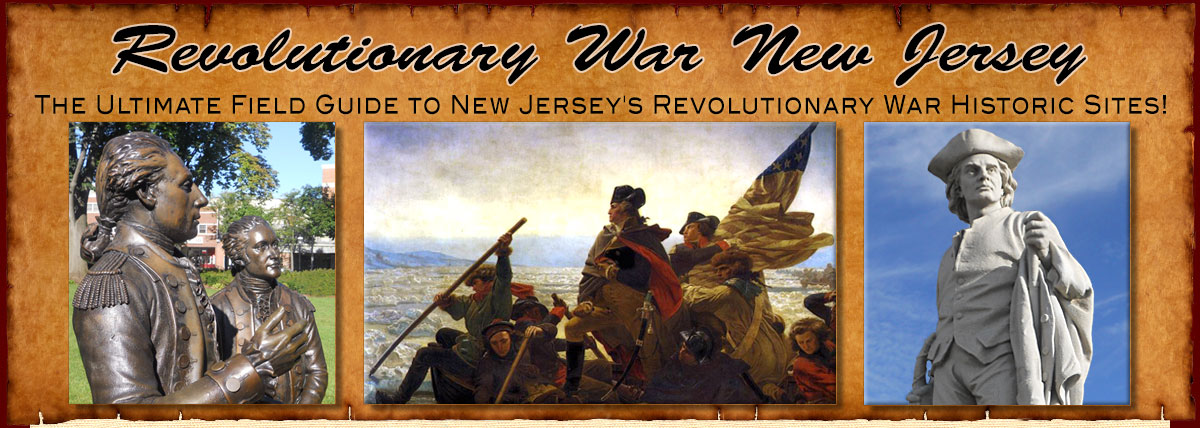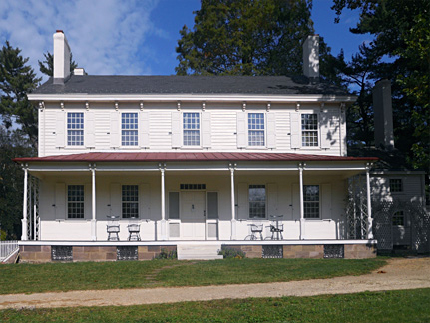


Historic Walnford
62 Walnford Rd.
Map / Directions to Historic Walnford
For current hours and admission information, see the
Walnford Page on the Monmouth County Parks Website
Historic Walnford Brochure & Map PDF
Please note: There is much to see within Historic Walnford. However, other than the farmhouse (shown left), most of it relates to buildings and structures from after the Revolutionary War era.
Historic Walnford contains the farmhouse of Richard Waln, a prosperous Quaker merchant. Richard bought this property in 1772, and work was begun on the house (pictured above) in 1773. He and his wife Elizabeth began living here in 1774.
As a Quaker, Richard was a pacifist, and refused to take sides in the Revolutionary War. Because of this, Waln was classified as a Tory, and arrested. He then refused to affirm his allegiance to the government. [1]
The Journal of Elizabeth Drinker, a friend and neighbor of the Waln's, provides us with details about what happened to Richard at this time. In her October 22, 1777 entry, she wrote, "... Richard Waln is taken up, and sent to New York. He had his choice of 3 things, either to go to Jail, take ye Test, or go within ye English lines. Ye latter was chosen." [the 'Test' referred to was an Oath of Allegiance]
Having made the choice to go "within ye English lines," Richard went to Staten Island, in New York. The exact timeline and conditions of Richard Waln's arrest and return are a bit unclear, as illustrated by several later journal entries of Elizabeth Drinker. It also makes clear that when he was in New York, behind enemy lines, he was able to travel back to visit. [2]
November 26, 1777: Elizabeth notes that Richard Waln, among others, visited her house
December 11, 1777: "Near 10 o'clock this evening, who should come in but Rich. Waln - he came from New-York in a vessel with a number of others. He's hearty and well."
April 2, 1778: Elizabeth notes that Richard Waln, among others, visited her house
May 8, 1778: "Richard Waln, Isaac Horner, and S. Swett dined with us."
June 14, 1778: "Richard Waln dined with us. He seems at a loss how to determine, whether to stay here, or go."
June 17, 1778: "Capt Ford and Richard Waln took leave of us today, as also did our John Burket. Sammy Shoemaker and Daniel Cox have gone on board one of ye Vessels, as have also many other of ye inhabitants."
September 4, 1778: "H. D. received a letter from Rich Waln, dated from Walnford. We are pleased to find he is with his Family, but we do not yet know upon what terms." [H.D. referred to Elizabeth's husband Henry Drinker]
He returned home in August 1778, and was arrested again. He petitioned Governor William Livingston, and was permitted to remain home, promising to be a "good Subject.." [3]
After the war, Richard was known for his efforts as an ardent abolitionist. He was an active member of the New Jersey Society for Promoting the Abolition of Slavery. In a 1794 letter to then Congressman Elias Boudinot, Waln wrote, "...but how can we expect the Great Ruler of the Universe - who certainly has not abandoned his Work to chance, will smile on our endeavors when we in a most solemn appeal to him have declared that we hold all men to be free and are yet in the horrid practice of keeping them slaves." [4]
Before the Battle of Monmouth
Hessian troops are known to have passed by Walnford on June 24, 1778, four days before the Battle of Monmouth. They repaired a bridge over Crosswicks Creek, nearby the house, that had been destroyed by American troops. That bridge stood in the vicinity of the current bridge, but the exact location is unknown.
There is a story that is often told that when this occurred, Hessian General Knyphausen stopped for a meal at the Walnford house. However, there is no evidence to confirm or refute the Knyphausen meal story. [5]

1. ^ National Register of Historic Places Inventory - Nomination Form submitted for Walnford, 1976
This document is available as a PDF on the National Park Service website here2. ^ Elizabeth Drinker, Edited by Henry D. Biddle, Extracts From The Journal of Elizabeth Drinker, From 1759 to 1807, A.D. (Philadelphia J.B. Lippincott Company 1889) pages 39, 61, 68, 71, 90, 102,105,106,109,148, and 163
Available to be read at the Internet Archive here• I would like to point out the July 7, 1777 entry in Elizabeth's Journal, even though it is unrelated to Richard Waln. The surrounding entries deal with events related to the war, including soldiers being quartered in her house in January. However, her entry for this day simply reads, "This is ye 7th day of ye 7th month, 1777."
As I was reading through Elizabeth's journal entries, I found it very charming that she stopped to note the interesting fact that there were a bunch of sevens in the date. Little details like this connect us to the people of this time, because it reminds us that they weren't distant figures playing parts on some grand historical stage, but human beings like us.3. ^ Article on Documents of the American Revolution Exhibition at Monmouth County Library Headquarters, Manalapan, NJ October 2002: Facsimiles of Revolutionary War Era documents from the Monmouth County Archives, New Jersey Historical Society, New Jersey State Archives, and Special Collections of Rutgers University at Alexander Library Curated by Gary Saretzky Monmouth County Archivist
Available on the Monmouth County website4. ^ Quote from letter by Richard Waln to Elias Boudinot (March 18, 1794) appears on an explanatory plaque at Walnford titled No Safe Haven, which also states that he was an active member of the New Jersey Society for Promoting the Abolition of Slavery
Those interested in learning more about Richard Waln as abolitionist are directed to the following two articles about the research of Sue Kozel. Kozel, a historian who lives in Upper Freehold, has researched Richard Waln, and his anti-slavery work.
• Jennifer Kohlhepp, "Weighing Richard Waln Upper Freehold resident awarded grant to study Quaker abolitionist," Tri-Town News, NJ, April 30, 2009
Available to be read at the Tri-Town News website here• "New Jersey Historian and Professor to Speak About Abolitionist Richard Waln at MCCC Apr. 28", Mercer County Community College News website, April 12, 2010
In this article, Kozel is quoted as stating, "Waln built support for his local Monmouth County investigations that resulted in New Jersey Supreme Court cases that freed African Americans wrongly held as slaves," and "His contributions played an important part in American and New Jersey abolitionist history and later struggles over freedom and slavery."5. ^ Telephone interview with Sarah Bent, Historic Sites Supervisor, Historic Walnford, Monmouth County Park System, conducted on February 7, 2014.
Sarah Bent told me that, at the current time, there is no evidence to document the Knyphausen meal story, but that there is no evidence against it.
She also stated that there is documentation for Hessians passing by, and that the location of the original bridge would have been in the vicinity of the modern one, but the exact location is unknown.I would like to thank Sarah for taking the time to speak with me about Richard Waln and Historic Walnford.